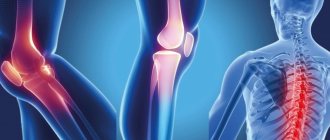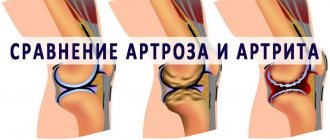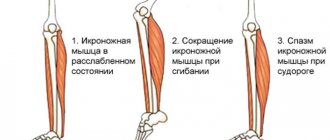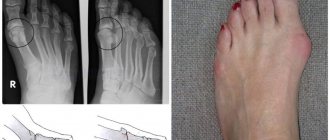Weakness in the legs often indicates simple fatigue, but sometimes this symptom indicates a more serious problem. In combination with dizziness, other pain, trembling, this symptom can indicate completely different pathologies. In what cases should you sound the alarm and rush to the doctor, and when is it enough to just rest?
Are you over 50? Don't ignore weakness in your legs
Common causes of leg weakness
Most often it occurs due to:
- long periods of standing – both static and dynamic;
- improperly selected shoes;
- a diet that causes constant hunger;
- transferred infectious diseases.
Morning weakness in the legs indicates endocrine disorders
Types of muscle weakness
Doctors distinguish the following forms of myasthenia gravis:
- sensory: the sensitivity of muscle tissue on the extremities increases (numbness, tingling, burning is observed);
- motor: severe muscle weakness, due to which a person practically cannot lift an arm or leg - this ailment can lead to muscle atrophy;
- sensorimotor: there is a combination of symptoms of the first two types of myopathy - this is the most common form of the disease;
- vegetative: in parallel with muscle weakness, increased sweating is observed, the skin becomes pale, the head is constantly dizzy, digestion is disturbed, the heart beats faster, breathing becomes difficult;
- mixed: combines the symptoms of all the above-described ailments.
Pathological causes
Pathologies in the lower extremities most often occur after 50 years of age, and they can be very serious. Most often, this symptom is diagnosed with:
- phlebeurysm;
- osteochondrosis;
- atherosclerosis of the legs, blockage and narrowing of the lumen of blood vessels;
- pinched nerves;
- blood pressure problems.
Diseases of the joints, in which degenerative processes develop in the tissues, are also not uncommon. It is at this age that treatment for arthrosis or osteoarthritis of the knee and hip joint is most often prescribed.
Weakness in the legs also occurs due to diabetes mellitus
Why does constant fatigue occur?
If there is a suspicion that weakness is caused by neurological or other pathological problems, then you need to contact a neurologist and have an MRI done.
But constant fatigue is often caused by an unhealthy lifestyle.
Chronic fatigue often manifests itself with the following symptoms:
- weakness in arms and legs;
- muscle pain;
- headache;
- deterioration of concentration and memory;
- immunity decreases, a person gets sick more often;
- intestinal upset, diarrhea;
- loss of appetite;
- chills;
- sweating;
- insomnia;
- there may be increased anxiety.
The body suffers greatly from stress. Therefore, first of all, you need to improve your lifestyle:
- Minimize stress and nervous tension.
- Get good sleep (at least 8 hours).
- Eat a nutritious, healthy diet.
- Drink plenty of fluids.
- Exercise.
- Go for walks and breathe fresh air.
- Take multivitamin and mineral complexes, as well as Omega-3 and Omega-6 preparations, to restore the lack of nutrients in the body.
How to recognize the cause
Doctors pay attention to accompanying symptoms and, if necessary, refer for additional examination.
- Simultaneous weakness in the legs and arms occurs with pathologies in the spine, but more often the cause is ordinary muscle fatigue caused by fasting and protein deficiency in the body.
- If the symptom is accompanied by dizziness and recurs frequently, you should immediately consult a doctor. In adolescents, this happens against the background of changes in hormonal levels and transformation of the autonomic nervous system. In adults - due to a head injury, a tumor in the brain, due to stress, severe starvation or pregnancy.
- Fever and leg weakness are obvious symptoms of a cold. Other options are infection, overheating or cooling, poisoning, severe emotional overload, prolonged exposure to ultraviolet radiation. Fever for more than two or three days is a reason to seek help.
- Trembling in the legs occurs when glucose is poorly absorbed - hypoglycemia. The body begins to experience a lack of oxygen, protein and carbohydrate metabolism is disrupted, the level of adrenaline in the blood increases - the nervous system reacts with trembling. Very often the body behaves in exactly the same way during normal anxiety.
- Weakness in the legs combined with headache may indicate acute chemical poisoning, in particular phosphorus-containing substances.
Is weakness accompanied by numbness in your legs? This is a very dangerous symptom
Diagnostic and treatment methods
To prescribe an effective and efficient treatment, you first need to diagnose and make the correct diagnosis. For myopathy, diagnosis includes interviewing and examining the patient, determining the time of onset, severity, possible provoking factors, and accompanying signs of the disease. Even when visiting a neurologist, the patient’s motor activity is analyzed using special exercises and testing reflex functions.
Diagnostic methods also involve conducting highly targeted tests:
- the level of enzymes in muscle tissue is determined (creatine phosphokinase, aspartate aminotransferase, alanine aminotransferase, lactate dehydrogenase, aldolase);
- the concentration of electrolytes (calcium, potassium) is determined;
- Immunological blood tests are carried out to identify antibodies;
- conducting electromyography and electroneurography allows you to check the functional balance between nerves, the neuromuscular synapse and muscles;
- an MRI of soft tissues is performed (if muscular dystrophy is implied), and an MRI of the brain (for a possible stroke);
- DNA analysis for specific mutations (with consultation of geneticists).
The Kuntsevo Medical and Rehabilitation Center in Moscow has all the necessary equipment that allows the above studies to be carried out. The clinic employs experienced neurologists who make accurate diagnoses, prescribe the correct treatment and help patients fully recover from their illness.
If we talk about treatment, then all measures are mainly aimed at treating the underlying diseases that led to muscle weakness. Specialists correct and compensate for dysfunctions of muscle tissue and internal organs. If necessary, doctors treat autoimmune diseases with the help of hormonal and cytostatic drugs that help suppress the production of antibodies and cellular aggression towards body tissues.
Muscle weakness, as a constant and long-term symptom, requires careful monitoring and consultation with a specialist.
IMPORTANT! Self-medication will not work to eliminate muscle weakness, because the appearance of a symptom may be associated with the pathology of various organs and systems of the human body.
Make an appointment with a therapist or neurologist at our center, who will determine the causes of persistent muscle weakness. If necessary, a therapist or neurologist will refer you to an experienced endocrinologist or rheumatologist at the Kuntsevo Medical and Rehabilitation Center, who will also investigate the causes of the symptom and treat the manifestation.
Sign up
When can leg weakness be dangerous?
If the symptom is accompanied by a feeling of “woolly legs” and this does not occur in extreme heat, not from overwork or starvation, we can assume more serious causes - a pre-heart attack and pre-stroke condition. In parallel with the weak legs, heart pain or headache appears, and the fingers go numb. Here the minutes are counting.
Sometimes the cause of weakness in the legs is anemia - a deficiency of vitamin B12. This symptom is especially dangerous in older age. How to proceed in this case?
Read also
Sudden memory loss/transient global ischemia
Transient, that is, temporary memory loss occurs in elderly patients and people suffering from migraines.
At the same time, memory for past and present events disappears. But the person is conscious, accessible... Read more
Facial paralysis (Bell's palsy/facial neuritis)
Facial paralysis is spontaneous weakness of ½ of the face. The cause is swelling of the facial nerve, as a result of its compression inside the temporal bone or in the outlet from it. Most often this leads to...
More details
Perinatal encephalopathy
Perinatal encephalopathy is a frequently encountered concept in the practice of pediatricians and pediatric neurologists! What it is? Literally, “perinatal encephalopathy” means “damage to the brain in the perinatal...
More details
Neurogenic bladder
In a healthy person, the process of urination is carried out in the form of a voluntary reflex act, and we can control it. However, this is not the case with this disease. Patients are extremely...
More details
Atherosclerosis
Atherosclerosis is a vascular disease that is caused by a decrease in the elasticity of the vascular wall, the deposition of cholesterol on the inner surface and, as a result, the appearance of atherosclerotic plaques. Atherosclerosis…
More details
If weakness is accompanied by pain
This is exactly the case when treatment for arthrosis of the knee, ankle or hip joint may be necessary. Pain syndrome can be eliminated by intra-articular injections of Noltrex, a synovial fluid substitute, provided that the orthopedist confirms the diagnosis.
If, in addition to pain, the patient complains of cramps, tingling and numbness, the skin on the legs turns blue or pale, other diseases are possible, for example, impaired blood circulation due to varicose veins or peripheral vascular disease. The same symptoms are characteristic of arthritis, bursitis, gout, pinched nerves due to radiculitis of the lumbosacral region, and even flat feet.
Weakness in the legs and pain occur with closed injuries of the lower extremities in athletes
Rehabilitation after treatment
Doctors at the Kuntsevo Medical and Rehabilitation Center pay special attention to rehabilitation, helping patients restore their lifestyle. This is due to the fact that due to lack of physical activity, muscles weaken over time. To restore mobility, doctors spend a long time working, and patients need to make a lot of effort. Additionally, therapeutic massage is provided for relaxation. Also, at the Kuntsevo Medical and Rehabilitation Center, many other measures are taken to rehabilitate patients with muscle weakness.
The most dangerous symptom
You should sound the alarm if weakness manifests itself not in both, but only in one leg, especially if one arm on the same side also goes numb. Very often this indicates a pre-stroke condition, when a vessel in the brain becomes blocked. You must call a doctor immediately.
Weakness in the left leg and loss or decrease in sensation indicate neurological pathology. In this case, you should also not hesitate, even if the symptoms are minor. Over time, the disease may develop into a tumor, disorders of the nervous system will worsen and lead to complications.
Weakness in one leg is a very alarming and dangerous symptom.
If you feel weakness in your legs that does not go away after rest and returns regularly, if it is also accompanied by pain or other symptoms of illness, do not attribute it to fatigue. The body signals you about problems that can be very serious. Start with a therapist, who will refer you to an orthopedist or neurologist and prescribe an examination.
If the reason is fatigue, an integrated approach is needed. It is necessary to establish a daily routine so that it harmoniously combines physical activity and rest. It is very important to eat well and spend more time in the fresh air. Make sure you wear good, season-appropriate shoes that don’t compress your limbs. But even if fatigue does not go away with such measures, consult a specialist.
Main symptoms of myasthenia gravis:
- 1. Decreased muscle strength. The measurement can be made either using a special tool - a dynamometer, or the hands of an examining doctor. To assess muscle strength without an instrument, the doctor simultaneously shakes the patient's two hands while assessing the symmetry of muscle tension.
- 2. Difficulty performing routine tasks (walking, climbing stairs, holding a mug in your hands, writing with a pen, carrying moderately heavy packages);
- 3. In addition to decreased strength in a particular limb, blepharoptosis (drooping of the eyelid), difficulty swallowing, speaking, or chewing may occur.
Weakness and drowsiness
Patients often complain that they want to sleep, but do not have enough strength for normal life activities. The combination of weakness and drowsiness is possible for the following reasons:
- lack of oxygen. The urban atmosphere is poor in oxygen. Constant stay in the city contributes to the development of weakness and drowsiness;
- decrease in atmospheric pressure and magnetic storms. People who are sensitive to weather changes are called weather dependent. If you are weather dependent, bad weather may cause your weakness and drowsiness;
- avitaminosis;
- poor or unhealthy diet;
- hormonal disorders;
- alcohol abuse;
- chronic fatigue syndrome;
- vegetative-vascular dystonia;
- other diseases (including infectious ones - in the early stages, when other symptoms have not yet appeared).
Weakness and dizziness
Dizziness quite often occurs against a background of general weakness. A combination of these symptoms may occur in the following cases:
- anemia;
- cerebrovascular accidents;
- a sharp increase or decrease in blood pressure;
- oncological diseases;
- stress;
- in women - during menstruation or menopause.










